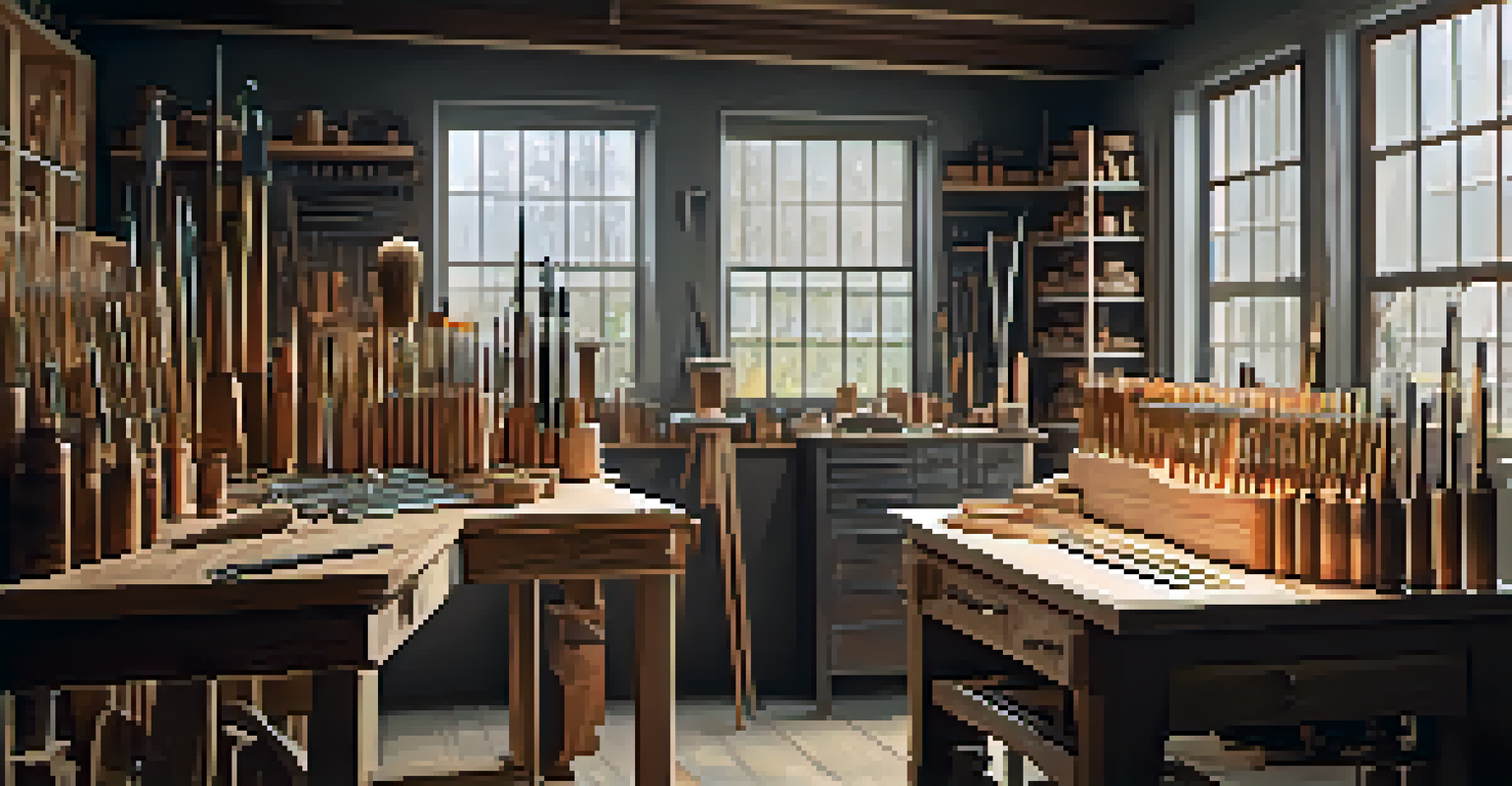Techniques in Carving: From Traditional to Modern Styles

Understanding Traditional Carving Techniques
Traditional carving techniques are steeped in history and cultural significance. Craftsmen have used tools like chisels and knives for centuries, often passing down their skills through generations. These methods emphasize precision and detail, showcasing the artisan's craftsmanship in every piece.
Art is not freedom from discipline, but disciplined freedom.
For instance, wood carving has roots in various cultures, from the intricate totem poles of Indigenous peoples to the delicate reliefs in European churches. Each style tells a story, reflecting the values and beliefs of the time. As a result, traditional carving can be seen as both an art form and a historical document.
Moreover, traditional techniques often involve the use of natural materials, such as wood, stone, and bone. This connection to nature not only enhances the aesthetic quality of the pieces but also fosters a sense of respect for the environment, a principle that many modern artisans still uphold.
The Tools of the Trade: Traditional vs. Modern
The tools used in traditional carving are typically simple yet effective. Carvers rely on hand tools like gouges, chisels, and mallets, allowing for a tactile connection with the material. This hands-on approach encourages a deep understanding of the medium and fosters a unique bond between the artist and their work.

In contrast, modern carving techniques often incorporate advanced tools like power routers and laser cutters. While these tools can significantly speed up the process, they also introduce new challenges, such as a reliance on technology. As a result, some artisans choose to blend traditional and modern methods, creating a harmonious balance between the two.
Traditional Techniques Are Vital
Traditional carving methods carry historical significance and cultural narratives, emphasizing the importance of craftsmanship.
Ultimately, the choice of tools can greatly influence the final outcome of a carving project. Traditional tools may allow for intricate detailing, while modern tools can enable precision and efficiency. It's essential for artists to choose the right tools based on their vision and the complexity of their design.
Exploring Different Styles of Traditional Carving
Traditional carving styles can vary widely across cultures, each with its own distinct characteristics. For example, African wood carving often features bold, abstract designs and vibrant colors, while Japanese woodblock printing emphasizes delicate lines and serene landscapes. These styles not only showcase the skills of the carver but also reflect cultural narratives and aesthetics.
The only way to do great work is to love what you do.
Another notable style is the intricate stone carving seen in ancient Greek and Roman sculptures. These pieces often depict mythological figures and historical events, showcasing the technical prowess of the artisans. The attention to detail in these works continues to inspire modern sculptors worldwide.
Understanding these traditional styles allows contemporary artists to draw inspiration and incorporate elements into their work, creating a fusion of old and new. This blending of styles can result in innovative pieces that pay homage to traditional techniques while also pushing the boundaries of contemporary art.
Modern Carving Techniques: Innovations and Trends
Modern carving techniques have evolved significantly, influenced by technological advancements and changing artistic trends. One of the most notable innovations is the use of CNC (Computer Numerical Control) machines, which allow for precision carving with minimal manual labor. This technology has revolutionized the industry, enabling artists to achieve intricate designs that would be nearly impossible by hand.
Additionally, modern carving often embraces mixed media, incorporating materials like acrylics, metals, and even recycled materials. This experimentation fosters creativity and encourages artists to think outside the box, leading to unique and thought-provoking pieces. As a result, modern carving not only focuses on aesthetics but also engages with themes of sustainability and innovation.
Modern Innovation in Carving
The integration of technology and mixed media in modern carving enhances creativity and introduces new artistic possibilities.
Furthermore, social media platforms have played a crucial role in showcasing modern carving techniques. Artists can share their processes and finished works with a global audience, fostering community and collaboration. This accessibility opens up new avenues for inspiration and learning, allowing carvers to connect and grow in ways that were previously unimaginable.
The Role of Carving in Contemporary Art
Carving has solidified its place in contemporary art, with artists using the medium to explore complex themes and emotions. Many contemporary carvers challenge traditional notions of beauty and craftsmanship, experimenting with unconventional materials and techniques. This push against the boundaries of carving invites viewers to reconsider their perceptions of art.
For instance, some artists utilize carving to convey social and political messages. By transforming everyday materials into thought-provoking pieces, they create a dialogue with their audience. This engagement not only elevates the medium but also emphasizes the relevance of carving in today's artistic landscape.
Moreover, contemporary galleries and exhibitions increasingly feature carving as a significant art form. This recognition encourages emerging artists to pursue carving, ensuring that the craft continues to evolve and thrive. The intersection of tradition and modernity in carving ultimately enriches the art world, fostering a diverse range of expressions.
Preserving Traditional Carving Techniques
As modern techniques gain popularity, the preservation of traditional carving methods becomes ever more crucial. Many artisans and organizations are committed to keeping these age-old practices alive, recognizing their cultural and historical significance. Workshops and apprenticeships provide opportunities for younger generations to learn from experienced carvers, ensuring that the knowledge is passed down.
Additionally, art schools and cultural institutions often offer courses focused on traditional carving techniques. These programs not only teach the skills but also emphasize the importance of understanding the cultural contexts behind the craft. By fostering a deeper appreciation for traditional methods, these initiatives help maintain the integrity of the art form.
Preserving Cultural Heritage
Efforts to preserve traditional carving techniques through education and community engagement are essential for maintaining cultural identity.
Moreover, online platforms and social media have emerged as valuable resources for sharing traditional techniques. Artists from around the world can connect, share their experiences, and inspire one another to keep these practices alive. This global exchange of knowledge ultimately strengthens the carving community and enriches the artistic landscape.
The Future of Carving: Blending Techniques and Styles
The future of carving is bright, characterized by a blend of traditional and modern techniques. As artists continue to innovate and experiment, we can expect to see unique pieces that draw from a rich tapestry of influences. This fusion allows for a dynamic exploration of form and function, pushing the boundaries of what carving can achieve.
Furthermore, the integration of technology into carving practices is likely to continue shaping the future of the craft. As new tools and methods emerge, artists will find fresh ways to express their creativity while honoring traditional techniques. This adaptability ensures that carving remains relevant in an ever-evolving art world.

Ultimately, the ongoing dialogue between traditional and modern styles enriches the carving community. By embracing change while respecting the past, artists can create works that resonate deeply with audiences and inspire future generations of carvers. The journey of carving is one of continuous evolution, celebrating both history and innovation.